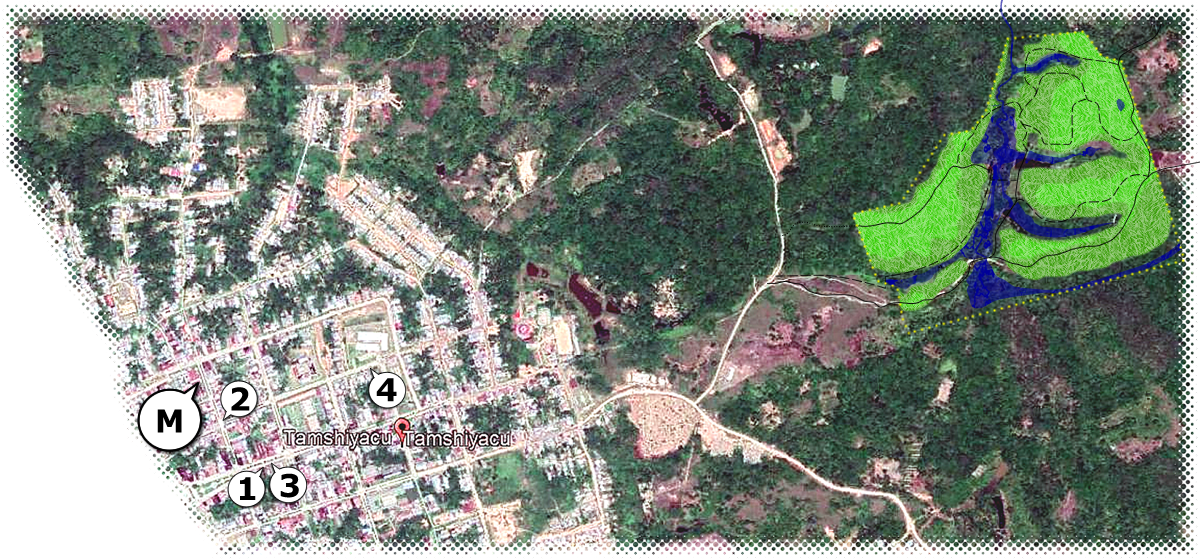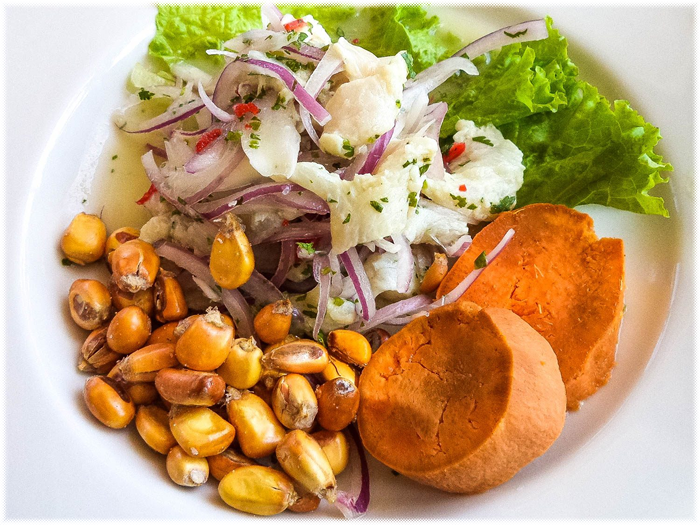ceviche
Ceviche, also cebiche, seviche or sebiche
Is a seafood dish typically made from fresh raw fish cured in citrus juices, such as lemon or lime, and spiced with ají, chili peppers or other seasonings including chopped onions, salt, and cilantro. Because the dish is not cooked with heat, it must be prepared and consumed fresh to minimize the risk of food poisoning. Ceviche is usually accompanied by side dishes that complement its flavors, such as sweet potato, lettuce, corn, avocado or plantain. The dish is popular in the Pacific coastal regions of Latin America. Though the origin of ceviche is hotly debated, in Peru it is considered a national dish.
Though archeological records suggest that something resembling ceviche may have been consumed in Peru nearly two thousand years ago, some historians believe the predecessor to the dish was brought to Peru by Moorish women from Granada, who accompanied the Spanish conquistadors and colonizers, and this dish eventually evolved into what is now considered ceviche. Peruvian chef Gastón Acurio further explains that the dominant position Lima held through four centuries as the capital of the Viceroyalty of Peru allowed for popular dishes such as ceviche to be brought to other Spanish colonies in the region, and in time they became a part of local cuisine by incorporating regional flavors and styles.
Preparation and variants
Ceviche is marinated in a citrus-based mixture, with lemons and limes being the most commonly used. In addition to adding flavor, the citric acid causes the proteins in the seafood to become denatured, appearing to be cooked. (However, acid marinades will not kill bacteria or parasitic worms, unlike the heat of cooking.) Traditional-style ceviche was marinated for about three hours. Modern-style ceviche, popularized in the 1970s, usually has a very short marinating period. With the appropriate fish, it can marinate in the time it takes to mix the ingredients, serve, and carry the ceviche to the table.
Most Latin American countries have given ceviche its own touch of individuality by adding their own particular garnishes.
Is a seafood dish typically made from fresh raw fish cured in citrus juices, such as lemon or lime, and spiced with ají, chili peppers or other seasonings including chopped onions, salt, and cilantro. Because the dish is not cooked with heat, it must be prepared and consumed fresh to minimize the risk of food poisoning. Ceviche is usually accompanied by side dishes that complement its flavors, such as sweet potato, lettuce, corn, avocado or plantain. The dish is popular in the Pacific coastal regions of Latin America. Though the origin of ceviche is hotly debated, in Peru it is considered a national dish.
Though archeological records suggest that something resembling ceviche may have been consumed in Peru nearly two thousand years ago, some historians believe the predecessor to the dish was brought to Peru by Moorish women from Granada, who accompanied the Spanish conquistadors and colonizers, and this dish eventually evolved into what is now considered ceviche. Peruvian chef Gastón Acurio further explains that the dominant position Lima held through four centuries as the capital of the Viceroyalty of Peru allowed for popular dishes such as ceviche to be brought to other Spanish colonies in the region, and in time they became a part of local cuisine by incorporating regional flavors and styles.
Preparation and variants
Ceviche is marinated in a citrus-based mixture, with lemons and limes being the most commonly used. In addition to adding flavor, the citric acid causes the proteins in the seafood to become denatured, appearing to be cooked. (However, acid marinades will not kill bacteria or parasitic worms, unlike the heat of cooking.) Traditional-style ceviche was marinated for about three hours. Modern-style ceviche, popularized in the 1970s, usually has a very short marinating period. With the appropriate fish, it can marinate in the time it takes to mix the ingredients, serve, and carry the ceviche to the table.
Most Latin American countries have given ceviche its own touch of individuality by adding their own particular garnishes.



